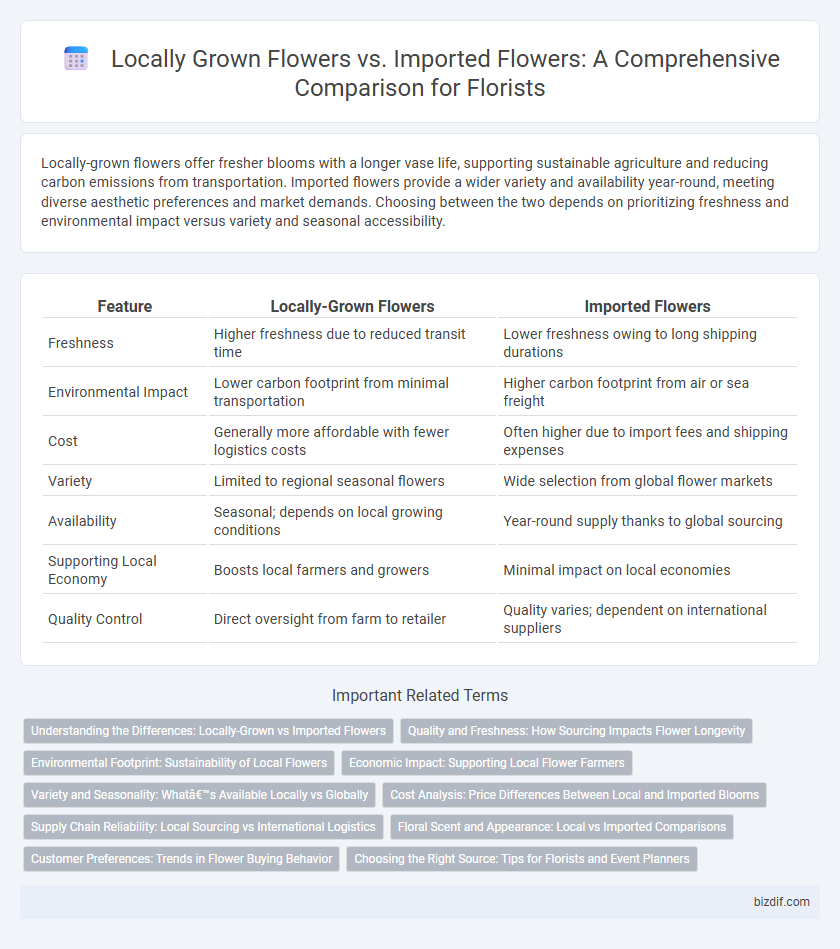Locally-grown flowers offer fresher blooms with a longer vase life, supporting sustainable agriculture and reducing carbon emissions from transportation. Imported flowers provide a wider variety and availability year-round, meeting diverse aesthetic preferences and market demands. Choosing between the two depends on prioritizing freshness and environmental impact versus variety and seasonal accessibility.
Table of Comparison
| Feature | Locally-Grown Flowers | Imported Flowers |
|---|---|---|
| Freshness | Higher freshness due to reduced transit time | Lower freshness owing to long shipping durations |
| Environmental Impact | Lower carbon footprint from minimal transportation | Higher carbon footprint from air or sea freight |
| Cost | Generally more affordable with fewer logistics costs | Often higher due to import fees and shipping expenses |
| Variety | Limited to regional seasonal flowers | Wide selection from global flower markets |
| Availability | Seasonal; depends on local growing conditions | Year-round supply thanks to global sourcing |
| Supporting Local Economy | Boosts local farmers and growers | Minimal impact on local economies |
| Quality Control | Direct oversight from farm to retailer | Quality varies; dependent on international suppliers |
Understanding the Differences: Locally-Grown vs Imported Flowers
Locally-grown flowers offer fresher blooms with longer vase life due to reduced transportation time, promoting sustainability by minimizing carbon footprints. Imported flowers provide a wider variety of exotic species and off-season options, though they often undergo longer shipping and chemical treatments to preserve freshness. Understanding these differences helps florists and consumers prioritize freshness, environmental impact, and flower selection based on their specific needs.
Quality and Freshness: How Sourcing Impacts Flower Longevity
Locally-grown flowers typically offer superior freshness and longer vase life because they are harvested at peak bloom and reach consumers faster, minimizing water loss and wilting. Imported flowers often endure extended transportation times and exposure to temperature fluctuations, which can compromise their quality and reduce their longevity. Selecting locally-sourced blooms supports a higher standard of flower freshness, vibrant colors, and sturdier petals essential for lasting floral arrangements.
Environmental Footprint: Sustainability of Local Flowers
Locally-grown flowers significantly reduce the environmental footprint by minimizing transportation emissions and supporting sustainable farming practices. These flowers often require fewer pesticides and less water due to adaptation to regional climates, promoting biodiversity conservation. Choosing local blooms fosters eco-friendly floristry by lowering carbon footprint and encouraging community-based agriculture.
Economic Impact: Supporting Local Flower Farmers
Purchasing locally-grown flowers directly supports regional flower farmers, boosting the local economy and creating sustainable job opportunities. Local floristry reduces transportation costs and carbon footprint, allowing funds to circulate within the community rather than flowing to international suppliers. Emphasizing local flowers helps preserve agricultural heritage and ensures fresh, seasonal blooms that benefit both consumers and local businesses.
Variety and Seasonality: What’s Available Locally vs Globally
Locally-grown flowers offer seasonal variety that aligns with regional climates, ensuring fresher blooms and supporting sustainable practices. Imported flowers introduce a wider selection of exotic species unavailable locally, providing year-round access to diverse colors and types. Balancing local seasonality with global availability allows florists to meet customer demand while promoting environmental responsibility.
Cost Analysis: Price Differences Between Local and Imported Blooms
Locally-grown flowers often have lower transportation and storage costs, resulting in more competitive prices compared to imported blooms which incur high shipping fees and longer shelf life expenses. Seasonal availability of local flowers reduces reliance on costly supply chains, allowing florists to offer fresher products at a reduced cost. Imported flowers typically carry premium prices due to customs duties, extended handling times, and specialized preservation methods required to maintain quality during transit.
Supply Chain Reliability: Local Sourcing vs International Logistics
Locally-grown flowers offer greater supply chain reliability by minimizing transit times and reducing risks associated with customs delays and international shipping disruptions. This local sourcing ensures fresher blooms and consistent availability, enhancing customer satisfaction and operational efficiency for florists. Conversely, imported flowers depend heavily on complex logistics networks, which are vulnerable to weather, political issues, and transportation bottlenecks, potentially causing delays and increased costs.
Floral Scent and Appearance: Local vs Imported Comparisons
Locally-grown flowers often possess a stronger, more vibrant floral scent due to fresher harvest times and minimal transportation, enhancing their sensory appeal in arrangements. The appearance of local blooms tends to be fresher and less bruised compared to imported flowers, which may experience delays and handling stress during shipping. Imported flowers offer a wider variety of exotic colors and species, but they can sometimes lack the robust fragrance and pristine look characteristic of locally-sourced blooms.
Customer Preferences: Trends in Flower Buying Behavior
Customers increasingly prefer locally-grown flowers due to their freshness, environmental sustainability, and support of local economies. Market data shows a rising trend in consumer demand for seasonal blooms that are often unavailable in imported varieties. Flower buyers also value traceability and reduced carbon footprints, driving a shift towards local floristry markets.
Choosing the Right Source: Tips for Florists and Event Planners
Choosing locally-grown flowers supports sustainable floristry by reducing carbon footprint and ensuring fresher blooms with longer vase life. Imported flowers provide diverse varieties and seasonal options not always available locally, ideal for unique or themed events. Florists and event planners should evaluate availability, cost, environmental impact, and client preferences to select the best flower sources for their designs.
Locally-Grown Flowers vs Imported Flowers Infographic

 bizdif.com
bizdif.com